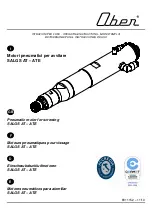
Wren 44 Gold Helicopter Owners Manual
Page 16
ALWAYS
carefully filter the fuel going into the tank, don’t rely on the pickup to stop particles
getting in. If a tank gets badly contaminated then discard it – this engine is far too costly to
risk a dirty tank. Be careful also to ensure any tank vents cannot suck grit into the tank. A
filter on the air vent is not going too far to keep the fuel pump in tip-top condition.
Fuel and kero burner valves
These are identical and interchangeable. To the
side is a flow direction arrow which should be
noted and adopted.
Test by simply blowing through while plugging it
into a spare servo outlet on your receiver. There
should be a click on powering. If it fails there is
little to be done but replace it. The quick release
connectors can be removed for re-use first
though. A test function for each valve can also be
accessed on the ECU via the “TEST” menu on the HDT.
ECU Battery
The ECU battery supplied is a 2-cell 7.4v Lithium
Polymer (LiPo, capacities vary according to
supply. The capacity of this should be enough for
at least three to five good flights but initially we
recommend you charge after each flight to keep
tabs on how much is being taken out by the flight.
Many fliers try to use regulators on their helicopter in order to try to use a single battery for
ECU and receiver. Experience shows this does not work. The fuel pump needs high current
pulses to operate correctly and a regulator cannot handle this. Keep the batteries separate.
Only charge using a charger which includes a balancer to keep all cells equalized. The
battery includes a balancing lead, you must charge through this to ensure the balancer can
work correctly.
Warning
. It is very important you disconnect the battery from the ECU before charging, or
permanent damage will result (chargers emit high voltage pulses). Such damage is
checkable and ECU’s so damaged will not be replaced under warranty. It is strongly
recommended to remove the battery from the airframe and charge in a safe area.
The Wren team witnessed a serious battery fire on a heli, caused by charging a LiPo without
ever using a balancing lead. The battery had become unbalanced and broke down on
charge. In this case the battery was inaccessible and the model went up in flames and the
owner could do nothing to stop it and was a very unhappy sight. Always use a balancer.
Battery care - after flying.
It is most important that the battery is disconnected at the end of
your flying session. The ECU uses only a few milliamps when shut off but this can discharge
a LiPo down to nothing in a couple of weeks. If this happens the battery will be deep
discharged and may be permanently damaged – ie scrap. A LiPo so discharged will not be
covered by the warranty.
















































